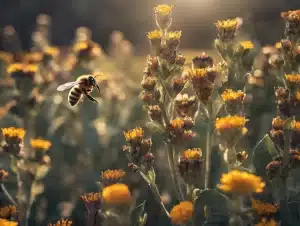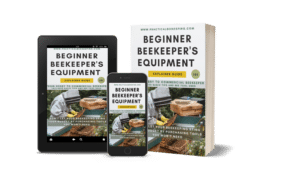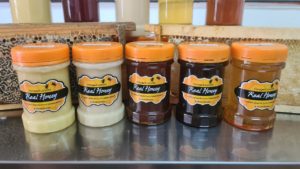To Your Beekeeping and Beeyond!
For many years now, over a decade, I’ve been influencing farmers like the Macadamia Association of South Africa and the Blueberry Growers as well as farmers alike.
Many beekeepers of old have told me in conversations that there is not enough food for more beekeeping hives in South Africa. I’ve proven over many years that this is not the case and here’s a few reasons why…
Macadamias Need Beekeepers
The Macadamian industry, notably supported by SAMAC and recently partnered with SABIO on national talks, has grown to be a world top producer! How does that effect bees?
Macadamia nuts don’t need pollination by bees however they can contribute an additional 12-17% increase in production. There’s usually low honey production when pollinating crops and orchards. Hence, the farmer pays the beekeeper to rent the hives as a compensation but also as part of the increased profit due to the service provided by the bees.
With an additional 5 351 new hectares of macadamias planted in 2020 this means just for the benefit of Macadamia pollination an additional 21,404 bee hives are required!
The challenge however comes in the pre- and post-management of the hives. Once the pollination period is done, the bees and hives must be relocated and to another food source.
The answer: there’s at least another 20 crops that pollination services can be applied to across South Africa and wherever else there is a large agricultural industry.
This Super Food is blooming for bees!
Blueberries are a growing production sector in South Africa and development is still in the early phase.
Pollination is an essential component of growing blueberries. To attain high levels of fruit set with large evenly-ripening berries requires bees to deposit enough pollen on stigmas during bloom. This can be done by honey bees, other managed bees, and wild bees. (This includes bumble bees but are not present in South Africa.)
The South African blueberry industry is small relative when compared to other local fruit industries. The area planted to blueberries is forecast to increase by 17 percent to 2,800 hectares (HA) in the 2020/21 from 2400 hectares in 2020/2019. As more blueberry farms came into production they have to have honeybee pollination services that boost production by at least 25% and fruit size by a grade. (P.S. This is BIG business for the farmer.)
The number of beekeeping hives needed to service pollination business for blueberries is 2400 HA multiplied by at least one bee hive per hectare under netting. Better results come from two bee hives per hectare and with varieties that can grow from May through to January in a year, there’s about 8 months of pollination income potential.
What’s the catch? To provide beekeeping pollination to a blueberry farmer it takes roughly 2.5x times the hectares under netting in pollination-ready bee hives to service the area. You also get very little honey remember which is why you have to rotate the pollinating bee hives off-site and replace them with strong built-up colonies during the entire period. And, the farmer cannot use pesticides as they will harm the bees.
Check out our interview with Prof Hannelie Human from Tukkies University as we discuss what honeybees do to blueberries on our video on youtube!
Are you a supporter of the green and gold?
The area under commercial avocado orchards stands around 14,700 hectares. According to Trevor Dukes, CEO of The Fruit Farm Group SA, the South African avocado sector needs to increase production from 10 tons to at least 15 – 20 tons per hectare to meet export demand and growing markets like China.
Well, if haven’t watched the Bee Ware® YouTube channel about beekeeping development ideas and business opportunities then here’s some another medium to pick it up from:
Avocados are the biggest beneficiaries of honeybee pollination when it comes to increasing yield!
Research, both in South Africa and Australia, has shown that pollination of four (4) hives per hectare can boost production by up to 300% on an individual avocado tree! This means that the average yield is about 50Kg per tree. However, when including honeybee pollination services this may increase up to 150Kg per tree!
Bear in mind, pollination and honey production are usually mutually exclusive. This is WHY farmers pay beekeepers when they provide pollination services. Negotiation on the price per hive is variable from crop to crop and each situation is subjective. However, it is a lucrative opportunity to provide pollination services. And you, as a beekeeper, contribute to the increase in food security while lowering the use of commercial pesticides in the practice.
P.S. With that 14,000 hectares of planted avocado orchards in South Africa, that crop would require at least 42,000 standard pollination bee hives to service them! As avocados flower up to 60 days it is a valuable pollination crop.
The South African avocado season spreads from February to November, with most fruit being harvested from March to September. This does include having to transport honeybee colonies across provincial lines and far distances. Scale of operation carries a lot of weight however there are enough pockets in zones with multiple crops with consecutive flowering periods.
A combination strategy of pollination for a high-yielding crop and service income can be used in tandem with a honey production timeline during the year. In other words, for certain crops as a beekeeper, you could decide to provide pollination services and then to build your bees up again seek honey producing crops with no commercial remuneration.
The old adage that there are not enough crops and opportunities for pollination services and honey producers is so last century… This year we will be building our service business and consulting for professional and commercial beekeeping industry stakeholders.






